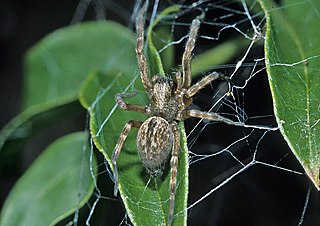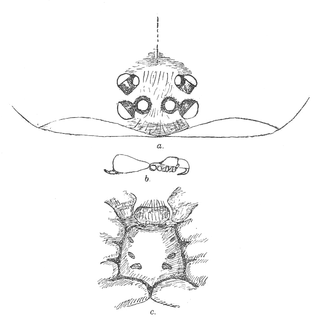
Amaurobiidae is a family of three-clawed cribellate or ecribellate spiders found in crevices and hollows or under stones where they build retreats, and are often collected in pitfall traps. Unlidded burrows are sometimes quite obvious in crusty, loamy soil. They are difficult to distinguish from related spiders in other families, especially Agelenidae, Desidae and Amphinectidae. Their intra- and interfamilial relationships are contentious. According to the World Spider Catalog, 2023, the family Amaurobiidae includes 286 species in 50 genera.

Cytaea is a genus of spiders in the family Salticidae.

Zenodorus is a genus of the jumping spiders distributed from the Moluccas to Australia, including several islands of the Pacific. It was once considered a junior synonym of Omoedus, but this was later rejected by Jerzy Prószyński in 2017. At least one species, Z. orbiculatus, specializes on hunting ants.

Idiopidae, also known as armored trapdoor spiders, is a family of mygalomorph spiders first described by Eugène Simon in 1889. They have a large body similar to tarantulas.

Migidae, also known as tree trapdoor spiders, is a family of spiders with about 100 species in eleven genera. They are small to large spiders with little to no hair and build burrows with a trapdoor. Some species live in tree fern stems. They have a Gondwanan distribution, found almost exclusively on the Southern Hemisphere, occurring in South America, Africa, Madagascar, Australia, New Zealand and New Caledonia.

Badumna is a genus of intertidal spiders that was first described by Tamerlan Thorell in 1890. They are harmless spiders that can be found around human structures and buildings. The most well-known species is B. insignis, also known as the "black house spider" or "black window spider".

Aname is a genus of mygalomorph spiders. It is endemic to Australia. The spiders, as well as some in closely related genera, are also known as wishbone spiders.
Aname diversicolor, the black wishbone spider, is a species of burrowing arachnid found in southern Australia.

Stanwellia grisea, also known as the Melbourne trapdoor spider, is a species of mygalomorph spider in the Pycnothelidae family. It is endemic to Australia. It was described in 1901 by British arachnologist Henry Roughton Hogg.

Cantuaria is a genus of South Pacific armored trapdoor spiders that was first described by Henry Roughton Hogg in 1902. From 1985 to 2006 it was merged with former genus Misgolas, now Arbanitis.
Blakistonia is a genus of Australian armoured trapdoor spiders that was first described by Henry Roughton Hogg in 1902.
Heteromigas is a genus of spiders in the family Migidae. It was first described in 1902 by Henry Roughton Hogg. As of 2016, it contains two Australian species.
Selenotholus is a monotypic genus of tarantulas containing the single species, Selenotholus foelschei. It was first described by Henry Roughton Hogg in 1902, and is found in the Northern Territory. It is distinguished from Selenocosmia in by a thoracic fovea recurved, along with the first and fourth pairs of legs being of equal size.

The Selenocosmiinae are a subfamily of tarantulas found throughout South-East Asia and Australia. This subfamily is defined by the presence of a lyra on the maxillae and strikers on the chelicerae, allowing these spiders to stridulate and produce a "hissing" sound. However some species within Phlogiellus may have secondary lost their lyra but retain their strikers. The monophyly of the subfamily has been only tested using genetic data with a handful of genera or species in a few studies. However, these studies found genera that had been previously placed in this subfamily were actual their own separate subfamily (Poecilotheria) and that Selenocosmiinae is most closely related to the Indian Thrigmopoeinae. As of 2021, Selenocosmiinae contains 11 genera.
Arbanitis andrewsi is a species of armoured trap-door spider in the family Idiopidae, and is endemic to South Australia.
Hadronyche meridiana, also known as the Central Victorian funnel-web spider, is a species of funnel-web spider in the Atracidae family. It is endemic to Australia. It was described in 1902 by British arachnologist Henry Roughton Hogg.
Heteromigas terraereginae is a species of tree trapdoor spider in the Migidae family. It is endemic to Australia. It was described in 1984 by Australian arachnologist Robert Raven.
Migas plomleyi, also known as Plomley's trapdoor spider, is a species of tree trapdoor spider in the Migidae family. It is endemic to Australia. It was described in 1989 by Australian arachnologists Robert Raven and Tracey Churchill.
Aname tasmanica is a species of mygalomorph spider in the Anamidae family. It is endemic to Australia. It was described in 1902 by British arachnologist Henry Roughton Hogg.
Blakistonia aurea, also known as the Adelaide trapdoor spider or the yellow trapdoor spider, is a species of mygalomorph spider in the Idiopidae family. It is endemic to Australia. It was described in 1902 by British arachnologist Henry Roughton Hogg.









